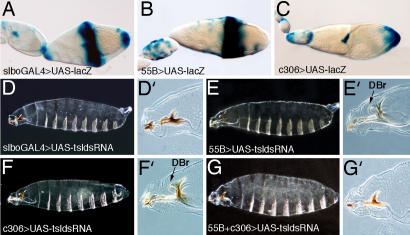Fig. 4.
RNAi-mediated inactivation of tsl indicates that BCs and CCs contribute to Tor receptor activation at the anterior end of the embryo. (A–C) Pattern of expression of the drivers used to induce the expression of UAStsldsRNA. (D) Expression of UAStsldsRNA with slboGAL4 in both BCs and CCs cause an anterior tsl phenotype. (D′) Detail showing absence of the dorsal bridge. (E) Expression of UAStsldsRNA with the 55B driver does not produce an anterior tsl phenotype. (E′) Detail showing formation of the dorsal bridge (arrow). (F) Similarly, expression of UAStsldsRNA with the C306 driver does not produce an anterior tsl phenotype. Expression of UAStsldsRNA with this driver in the PFCs also gives rise to some embryos with a posterior tsl phenotype. (F′) Detail showing formation of the dorsal bridge (arrow). (G) However, expression of UAStsldsRNA with both the 55B and C306 drivers causes an anterior tsl phenotype. (G′) Detail showing absence of the dorsal bridge. In all images, anterior is to the left and posterior is to the right.

